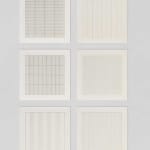Agnes Martin 1912-2004
Paintings and Drawings 1974-1990 (Stedelijk), 1991
complete set of ten lithographs on transparent vellum paper
each, 30 x 30 cm
11 3/4 x 11 3/4 in
11 3/4 x 11 3/4 in
edition of 2500
Further images
-
(View a larger image of thumbnail 1
)

-
(View a larger image of thumbnail 2
)

-
(View a larger image of thumbnail 3
)

-
(View a larger image of thumbnail 4
)

-
(View a larger image of thumbnail 5
)

-
(View a larger image of thumbnail 6
)

-
(View a larger image of thumbnail 7
)

-
(View a larger image of thumbnail 8
)

-
(View a larger image of thumbnail 9
)

-
(View a larger image of thumbnail 10
)

-
(View a larger image of thumbnail 11
)

Published to celebrate the Artist's 1991 retrospective at the Stedelijk Museum, Amsterdam. Printed by Lecturis, Eindhoven; published by Nemela & Lenzen GmbH, Monchengladback and Stedelijk Museum, Amsterdam. Known for her...
Published to celebrate the Artist's 1991 retrospective at the Stedelijk Museum, Amsterdam. Printed by Lecturis, Eindhoven; published by Nemela & Lenzen GmbH, Monchengladback and Stedelijk Museum, Amsterdam.
Known for her deeply soothing and intricately ordered abstractions, painter Agnes Martin developed an artf orm that was deeply influenced by Zen Buddhism, American Transcendentalism, and the placid complexity of the landscape. Martin produced a body of work distinguished by its use of orderly grids and calm lines executed in a soothing and organic palette. While she has been associated with both the Abstract Expressionists and the Minimalists, Martin’s painting evades classification; she charted new terrain that existed outside of the traditional conventions of the painterly avant-garde, producing a novel art form that envelops the viewer in its soothing totality, creating an effect much like the entrancement produced by the relentless sound of crashing waves.
Martin’s work is intimately tied to place and pattern. Throughout her career, she worked between the arid deserts of Taos, New Mexico and the concrete canyons of Lower Manhattan. The work Martin produced in each place reflects the material experiences of localised being, tempered by manifestations of the artist’s lifelong habits of meditation and her adherence to Buddhist and Transcendentalist teachings. Martin’s work was widely celebrated during her lifetime, as she was represented by the prestigious Betty Parsons Gallery, but it has experienced in recent years a renaissance of public opinion with recent retrospectives at Tate, London in 2015 and the Solomon R. Guggenheim Museum, New York in 2016.
Known for her deeply soothing and intricately ordered abstractions, painter Agnes Martin developed an artf orm that was deeply influenced by Zen Buddhism, American Transcendentalism, and the placid complexity of the landscape. Martin produced a body of work distinguished by its use of orderly grids and calm lines executed in a soothing and organic palette. While she has been associated with both the Abstract Expressionists and the Minimalists, Martin’s painting evades classification; she charted new terrain that existed outside of the traditional conventions of the painterly avant-garde, producing a novel art form that envelops the viewer in its soothing totality, creating an effect much like the entrancement produced by the relentless sound of crashing waves.
Martin’s work is intimately tied to place and pattern. Throughout her career, she worked between the arid deserts of Taos, New Mexico and the concrete canyons of Lower Manhattan. The work Martin produced in each place reflects the material experiences of localised being, tempered by manifestations of the artist’s lifelong habits of meditation and her adherence to Buddhist and Transcendentalist teachings. Martin’s work was widely celebrated during her lifetime, as she was represented by the prestigious Betty Parsons Gallery, but it has experienced in recent years a renaissance of public opinion with recent retrospectives at Tate, London in 2015 and the Solomon R. Guggenheim Museum, New York in 2016.










